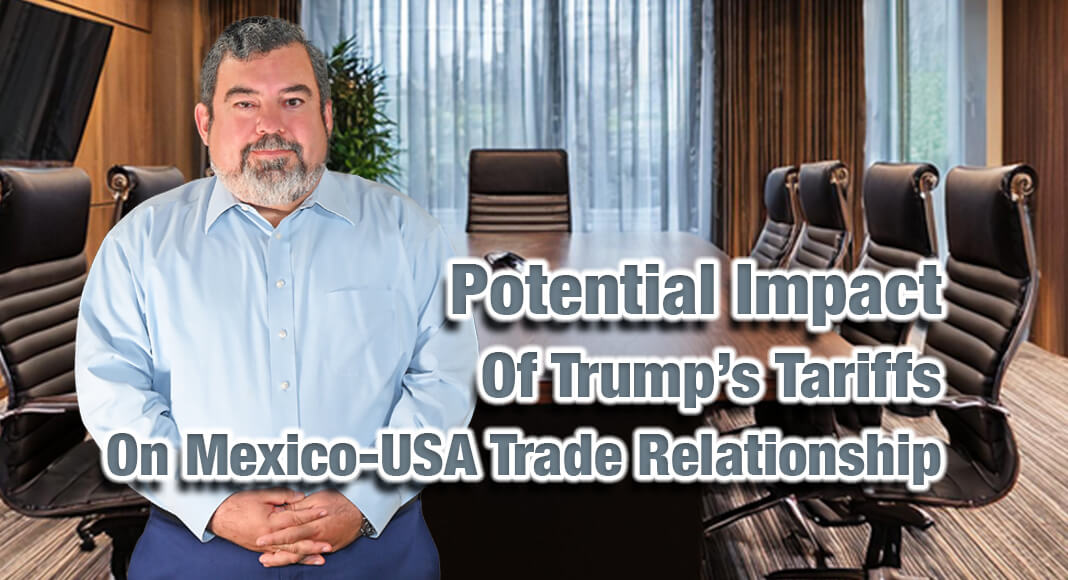
Texas Border Business
By Roberto Hugo González
In a presentation given in Reynosa on January 8, 2025, during a meeting organized by the Customs Committee for INDEX Reynosa, Jorge A. Torres, President of Interlink Trade Services and a U.S. Customs Broker, discussed the potential implications of the Trump administration’s proposed tariffs on the Mexico-U.S. trade relationship. These tariffs, which could take effect as early as January 20, 2025, signify a major shift in trade policy with widespread impacts on industries in both countries.
Torres highlighted that the tariffs would impose a 25% additional duty on goods imported from Mexico and Canada, alongside a 10% to 20% tariff on imports from other nations. China, already a frequent target of U.S. trade measures, would face a 10% tariff under this plan. Unlike previous measures, these tariffs would apply universally, including to countries with existing free trade agreements (FTAs) with the United States. This provision would also extend to IMMEX companies, which rely heavily on temporary imports of U.S. goods for manufacturing operations.
The motivations behind these tariffs stem from two key objectives. On one hand, national security concerns, including immigration control, combating drug trafficking, and addressing fentanyl production linked to China, drive the measures. On the other hand, economic policy goals aim to bolster U.S. domestic industries and reduce dependence on imports. By targeting these areas, the administration seeks to reshape the economic landscape and reinforce its geopolitical strategies.
Torres detailed the mechanisms enabling the U.S. government to enact these tariffs without Congressional approval. These include Section 301, previously used against China; Section 232, used for steel and aluminum tariffs; and Section 201, which targets solar panels and washing machines. The International Emergency Economic Powers Act (IEEPA) also grants broad powers for economic actions. Despite the protective frameworks established by the USMCA, such tariffs can still be unilaterally implemented, though they leave the U.S. vulnerable to legal challenges from its trading partners.
The ramifications for supply chains and market dynamics are profound. Torres noted that the tariffs would likely disrupt established trade routes, necessitating the exploration of alternative suppliers and logistics channels. The increased costs of customs compliance, paired with the inflationary pressures of higher tariffs, will drive up consumer prices and reduce competitiveness, particularly for small businesses unable to absorb the additional costs.
The potential impacts on Mexico are particularly terrible. Given the high level of economic interdependence between the two nations, critical industries such as automotive, electronics, and agriculture could face significant challenges. Torres warned of possible closures of manufacturing plants and reductions in production lines, which could result in higher unemployment and wage stagnation across the IMMEX sector.
Torres outlined several strategies to mitigate the effects of tariffs. He emphasized the importance of proactive customs planning, leveraging FTAs, and using valuation methods to avoid unnecessary tariff payments. Programs such as 9801 and 9802, which offer tariff relief for U.S. components assembled overseas, along with mechanisms like Foreign Trade Zones and bonded warehouses, were recommended to reduce costs. Diversifying suppliers and negotiating cost-sharing arrangements with partners were also identified as vital measures for businesses.
The broader implications of the tariffs extend beyond immediate economic impacts. Torres predicted the possibility of a trade war between Mexico and the U.S. should Mexico retaliate with its own tariffs. This scenario could lead to currency devaluation in Mexico as a countermeasure and further complicate the bilateral trade relationship. Mexico’s efforts to balance its role in nearshoring while addressing U.S. pressures to limit Chinese investments in the region will place it in a difficult position.
Torres’ presentation emphasized that these developments are part of a broader trend toward protectionism and regionalization, often called “Globalization 2.0.” As global supply chains become more localized, politics will play an increasingly critical role in shaping trade policies and economic alliances. With the USMCA slated for review in 2026, both nations face a critical period of adaptation and negotiation.
Torres concluded by urging businesses and policymakers to remain vigilant and proactive in the face of these challenges. By leveraging available tools and fostering clear communication across all levels, stakeholders can navigate the uncertain terrain ahead and preserve the mutually beneficial trade relationship between Mexico and the United States.
See related story:













